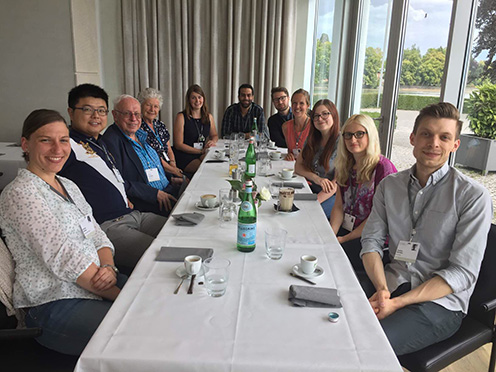Syntrain fellow in Lindau Nobel Laureate Meeting
Syntrain Fellow Timo Reisländer participated in the 68th Lindau Nobel Laureate Meeting, and he here reports his personal experiences and impressions from the event!

Every year, the Nobel Laureate Meeting hosts a few dozen Nobel laureates and hundreds of PhD-students and post-docs in Lindau, Germany. This year’s Nobel Laureate Meeting dedicated to Medicine or Physiology welcomed 39 Nobel Laureates and 600 young scientists from 84 different countries. I was honoured to be one of the Marie Skłodowska-Curie Fellows selected to participate.
4 days program
The meeting started with an opening ceremony on Sunday, 24 June. This included a speech by Nobel Laureate Elizabeth Blackburn on the role of science in society and politics. Following that, partners of the event invited young scientists for a drinks reception. I was invited by the ‘Klaus Tschira Stiftung’, a foundation supporting science communication in Germany.
The next four days followed more or less the following schedule. The morning usually began with discussions on current issues in biomedical research. I chose to join a discussion on ‘Developing Stronger Science Leadership in Different Cultures’ in one morning and on ‘Gene Modification’ in another morning. This was followed by two lectures where Nobel Laureates gave a 30 min talk focused on their past and present research outcomes. Afterwards, during two so called Agora Talks 1 or 2 Nobel laureates gave a 10 - 20 min presentation followed by questions from the audience. However, the topics were not necessarily linked to the laureate’s research. For example, Sir Richard J. Roberts discussed on the public perception on GMOs. The afternoon started with a panel discussion on topics like ‘Challenges in Personalised Medicine’ or ‘Publish or Perish’.
Open Exchange sessions and inspirational discussions
Before dinner, there were Open Exchange sessions which had more of a discussion character. Here, 1 or 2 Nobel Laureates answered questions from the audience. In contrast to the Agora talks, the young scientists decided on the topics of the discussion by asking concrete questions. During dinner there were plenty of opportunities to interact with Nobel Laureates as well as with other young scientists. For Thursday’s dinner, everyone was encouraged to wear a traditional outfit from their country of origin. Therefore, I was wearing Bavarian Lederhosen.
On one day, I had the chance to have lunch with laureate Thomas Lindahl who received the 2015 Nobel prize for mechanistic studies of DNA repair. This is exactly the field I am working on and we had a very interesting and stimulating discussion.

On the last day, a boat trip to the island Mainau was scheduled. On the island, there was a panel discussion on ‘Science in a Post-Factual World’. On the way back to Lindau, the meeting ended with a party on the boat.
To summarise, the Nobel Laureate Meetings are a unique conference. For me personally the most rewarding part of the meeting were not the Nobel Laureates or the boat trip but the interaction with the other young scientists. It was a very inspirational experience and I am more than ever encouraged as a scientist to follow my passion and curiosity.
